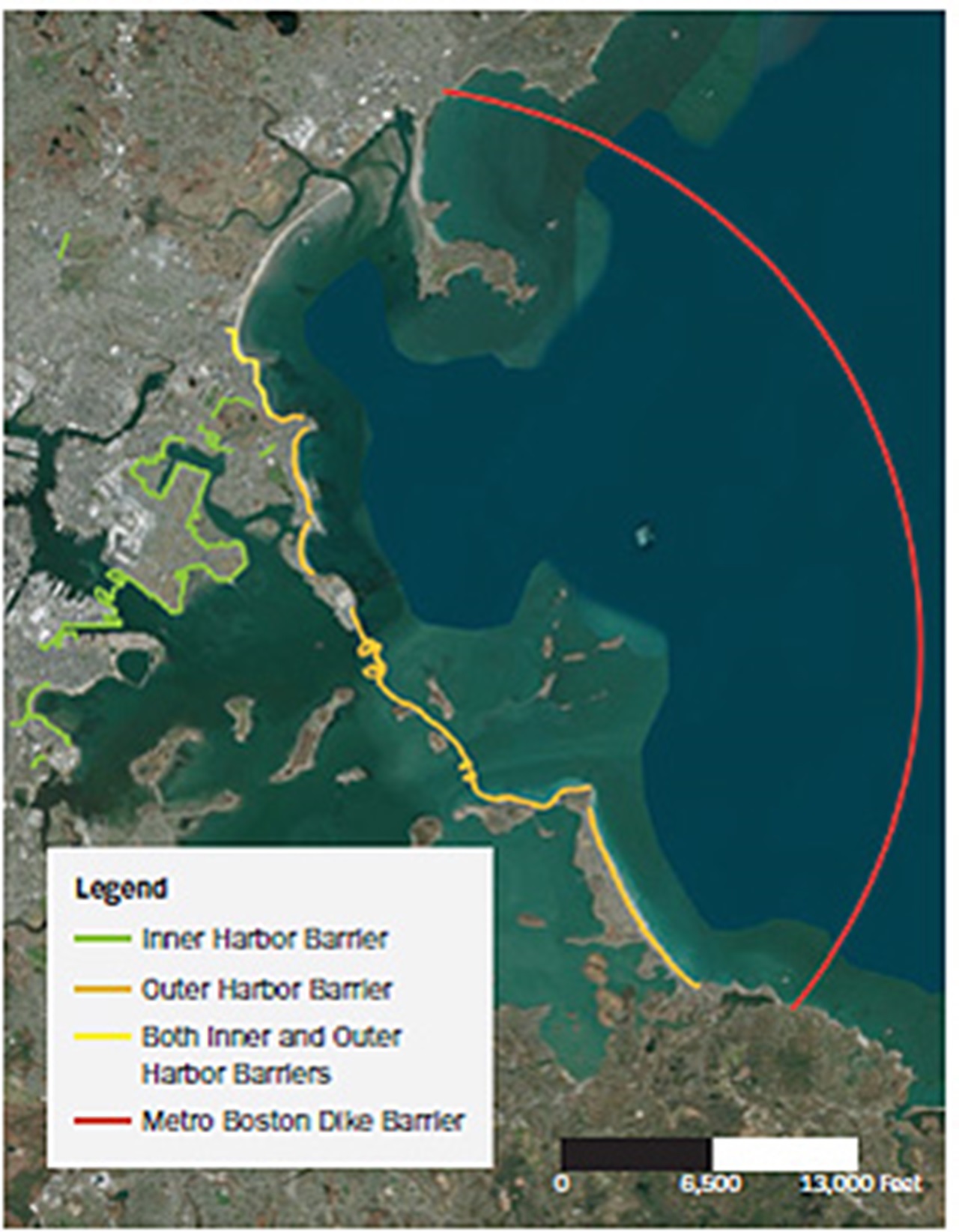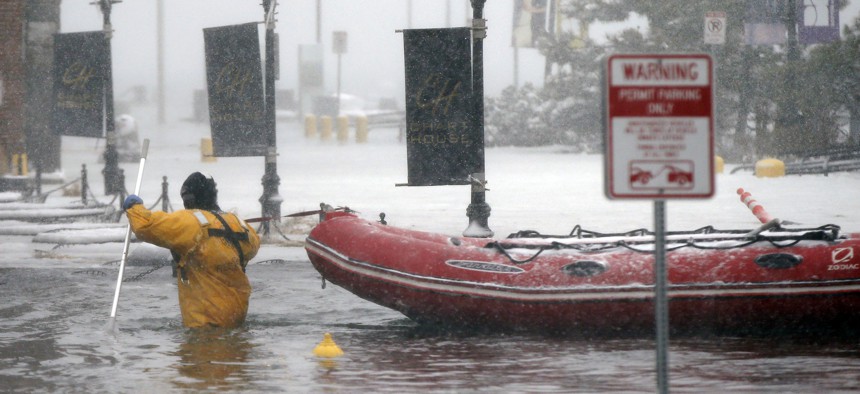Connecting state and local government leaders
City planners now say they are increasingly turning to methods aligned with the Dutch concept of “living with water.” Instead of resisting water, cities are channeling it to where they want it to go.
This article was originally published by Stateline, an initiative of The Pew Charitable Trusts.
To protect itself from a devastating flood, Boston was considering building a massive sea wall, cutting north to south through nearly 4 miles of Boston Harbor, taking $11 billion and at least 30 years to build. But a new plan unveiled in October represents a 180-degree turn: Instead of fighting to keep the water out, the city is letting it come in.
Boston Mayor Martin Walsh, a Democrat, announced the city would be scrapping the idea of a sea wall in favor of, among other things, a system of waterfront parks and elevation of some flood-prone areas. The city will add 67 new acres of green space along the water and restore 122 tidal acres.
The idea is to give people access to the shoreline when the weather is nice, but when the parks get flooded—well, it’s not that big of a deal.
As climate change forces cities to grapple with rising sea levels and increasingly powerful storms, coastal cities must prepare for a heightened likelihood of flooding, whether tidal flooding from rising sea levels or a hurricane that could dump inches of rain in a short period of time.

For the last hundred years, protecting neighborhoods has often meant relying on sea walls—large, concrete barriers designed to withstand strong waves and rising waters. Beyond not being particularly attractive, they are expensive, can cause erosion and harm marine life.
City planners now say they are increasingly turning to methods aligned with the Dutch concept of “living with water.” Instead of resisting water, cities are channeling it to where they want it to go. Boston’s reimagined waterfront would be designed to handle at least 21 inches of sea-level rise, which the city anticipates by 2050.
“Besides taking decades to complete, a barrier would bring its own set of serious ecological issues,” Walsh recently told a crowd at the Greater Boston Chamber of Commerce. “Shoreline projects are more feasible and more effective ways to increase our city’s resilience. … This is our vision of a resilient Boston. It’s a system not of barricades but of beaches—and parks and trails and open spaces.”
To be sure, cities on coasts from Florida to Hawaii are continuing to repair sea walls and build new ones as climate disasters loom. In areas that have long been heavily reliant on such walls, it can be difficult to change course, particularly when industry relies on being able to navigate nearby waters.
But planners are working to incorporate strategies called “soft solutions” in contrast to harder infrastructure like sea walls. Similar projects are being planned across the Hampton Roads area in Virginia, home to Norfolk and Virginia Beach, which is one of the nation’s most at-risk areas for flooding. Tide gauges there show the water level is 14 inches higher than it was in 1930.
Downtown Norfolk is protected by a sea wall that was built in the 1960s for $5 million but now protects about $800 million worth of infrastructure. The Army Corps of Engineers and the city are assessing plans to replace or reinforce that wall. The city also is developing plans for a series of parks and wetlands in other portions of the city.

“It’s a new movement,” said Michelle Covi, an assistant professor of ocean, earth and atmospheric sciences at Old Dominion University, in Norfolk, who helped develop plans in the Hampton Roads area. “Even in the Army Corps of Engineers, they’ve accepted this as a way to protect valuable infrastructure but also allow us to have a connection with the water.”
Kyle Spencer, the deputy resilience officer for Norfolk, said the city hopes to create more parks outside its urban core that are protected with earthen berms that can be raised by adding dirt and can serve as walking and bike paths along the water. Wetlands can be created to help protect those berms, and the city plans to also set up oyster colonies to help keep the water clean and protect the vegetation behind them.
In Boston, the city proposes elevating areas along 47 miles of shoreline, such as Charlestown’s Main Street and downtown’s Harborwalk. The city also distributed drawings showing berms and terraced walls leading down to the waterfront.
The city’s shift away from a big sea wall was sparked in large part by research at the Sustainable Solutions Lab at the University of Massachusetts, Boston. The aptly named “Feasibility of Harbor-wide Barrier Systems” report laid out the time and expense of a wall—along with a host of navigational and environmental issues.
“We found that, dollar for dollar, we could have the same amount of protection for much less cost, and in doing so also invest in our neighborhoods and have more green space,” said Rebecca Herst, director of the lab. She described the parks as a twin solution—those along the shore can rebound quickly if flooded, while further inland, having less concrete and more permeable surfaces can help absorb water.
Such solutions may be far cheaper than sea walls, but they still will be expensive.
Walsh said the city will devote 10 percent of its capital budget to climate change projects, about $16 million a year. The consensus among supporters of the plan is that it won’t be enough. The city also is seeking federal money and is in the early stages of determining the private sector’s role.
Walsh made the announcement at a chamber of commerce meeting, because he wants to bring the business community on board.
While local environmental groups lauded the plan, the Charles River Watershed Association said it didn’t go far enough, and that developers should face stronger building requirements and even restrictions on where they can build.
Sea Wall Fights
Sea walls still may be necessary in some circumstances.
The Army Corps of Engineers recently unveiled options for protecting New York Harbor from flooding and storms like Hurricane Sandy, which caused massive damage in 2012. One of the proposals calls for a 5-mile sea wall from Sandy Hook in New Jersey to Breezy Point in New York.
The scope of that sea wall would be far beyond anything either state has evaluated previously, and the proposal would include smaller barriers and levees to help connect the system that would run the length of the outer harbor.
Alternatives include a smaller series of inner harbor gates or six small barriers with lots of levies. One option proposes no barriers, just nature-based solutions along the shorelines.
Some environmentalists and officials who help areas prepare for climate change have already expressed concern about the early proposals. The Natural Resources Defense Council said offshore storm surge barriers would “strangle the life” out of the area’s waterways.
Beth Gibbons, executive director of the American Society of Adaptation Professionals, said cities in the region have turned to greener solutions after Hurricane Sandy, and pointed to Governor’s Island which, remodeled to include a larger park, will return to its geological purpose as a barrier island. She cautioned that adding a sea wall, while protective in some areas, could lead to problems in others.
“When you put up a sea wall, there’s an end,” she said. “We’ve seen time and again that water will find its path. If you put up a sea wall, you will likely be making choices about who is protected and who is not. You’re picking winners and losers, and that has to be done with a lot of care.”
Once a sea wall is in place, it can be difficult to pursue other options.
“It’s part of our legacy,” said James Murley, the chief resilience officer for Miami-Dade County. Canals with cement walls weren’t viewed as drainage but as an amenity to connect homeowners to waterfront recreation.
Across South Florida, local governments are looking to maintain existing sea walls while expanding green infrastructure where it makes sense. Other cities are making similar calculations.
Hawaii recently approved a new sea wall on Maui for the first time in almost a decade. Oceanfront condo owners whose property would be protected supported the wall, while environmentalists sued to stop it. Elsewhere in the state, the government will be paying to repair crumbling sea walls.
The state initially fought having to take over the costs of fixing a wall near Honolulu, but Hawaii’s Supreme Court ruled the government would be responsible because the wall has become a beach access point. The legislature will still be responsible for doling out funds to repair sea walls.
In Norfolk, Spencer said the city is debating whether to add height to its existing sea wall or replace it. City officials in San Francisco will ask voters to approve a $425 million bond issue to upgrade its hundred-year-old sea wall. But the city also has some projects in the works to protect shorelines, such as planting oyster and eelgrass beds at least 150 meters offshore.
Skip Stiles, director of Norfolk-based Wetlands Watch, which promotes nature-based solutions to sea-level rise, said the city is too developed and too dependent on Navy activities to abandon sea walls in favor of greener solutions.
“Some places are going to need a big structure,” he said. “The end of a naval airstrip is going to need a big structure. You can’t tie a tanker to a wetland.”

NEXT STORY: Flying at Peak Thanksgiving Travel Times Through These 10 Airports? Good Luck.



